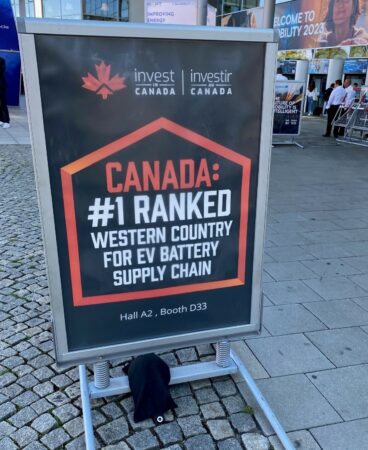Canada must act now to be leader in the hydrogen economy
In early September I had the opportunity to travel to Munich as part of a House of Journalists expedition to cover the IAA Mobility show and related press conferences. I came back feeling more convinced than ever that hydrogen will play a key role in decarbonizing transportation and concerned that Canada is falling behind the race to develop a hydrogen economy.
It should be noted the Maple Leaf was flying all over the show floor and outside entranceways. Signage, sponsored by Invest in Canada, touted our country as “The #1 Western Country for EV Battery Supply Chain.” I visited its pavilion and learned this distinction was bestowed by BloombergNEF, a research group that placed Canada only behind China in its global rankings, and indeed the best performer in the west.
Canada’s rise was credited to its large raw material resources and mining activity, strong environmental, social and governance (ESG) commitments, and available infrastructure, innovation and industry. Our ranking was bolstered by an increasing commitment for cell and component manufacturing here.
This has come at an enormous cost, of course. The federal government threw a mind-boggling $13 billion toward Volkswagen to open a battery plant in St. Thomas, Ont. When this was publicly revealed, auto rival Stellantis returned to the bargaining table with its hat out, even temporarily halting production at its own Ontario plant. It left those renegotiations feeling whole, having received up to $15 billion. And there are others. GM, Ford and others have also received subsidies to build EVs and related components here.
The mounting costs of attracting the EV battery industry mean it could be decades before taxpayers see a return. The Parliamentary Budget Officer (PBO) put out a report indicating it will be 20 years before the feds break even on those two investments alone.
There is absolutely value in courting global EV makers and their suppliers to Canada. And we are admittedly against tough competition, especially with our neighbors to the south allocating big bucks under the Inflation Reduction Act to bring similar industry to the U.S.
The buzz about hydrogen trucks
But look beyond passenger cars, to commercial vehicles, and the buzz at IAA Mobility was more about hydrogen than battery-electric vehicles. The payload and range required of commercial trucks means, in many use cases, BEVs don’t make sense. Hydrogen does. It’s more energy-dense. A hydrogen-fueled truck can be filled in 10-20 minutes compared to hours of charge time required by BEVs.
But despite efforts to bring zero-emissions vehicle and related component manufacturing to Canada, I worry we are at risk of falling behind the rest of the world when it comes to providing the hydrogen fueling infrastructure that will be vital if Canada is to meet its Paris Agreement commitments to decarbonize transportation.
“We know we can’t decarbonize without hydrogen,” Dr. Stephan Herbst, technical head of hydrogen powertrain and fuel cell business with Toyota, told us during an interview. “If we want to decarbonize [transportation] we need to provide a variety of options.”
Hydrogen will be one of them.
Building a hydrogen economy
But if it doesn’t act soon, North America risks falling behind Europe and Asia in building a hydrogen economy. The U.S. has just about 100 hydrogen fueling stations today – many of them “behind the fence” or private. China has 260 with a plan to build 1,000 by 2025 and 5,000 by 2030. Japan has 164 hydrogen fueling stations with a target of 1,000. And Europe has committed to having a station every 200 km by 2030.
Canada has…plans. Hydra Energy is building a large-scale hydrogen fueling station in Prince George, B.C., and has customers lined up to use it fueling Hydra’s diesel/hydrogen dual-fuel platform. The Greater Toronto Airports Authority and Carlsun Energy have plans to build a fueling site at Pearson Airport in Toronto, which will be able to serve commercial trucks. It received $1 million in funding from Natural Resources Canada.
But it’s not nearly enough. Everyone I spoke to involved in hydrogen commercial vehicle production eyes Canada as a highly prospective market, where energy costs are low and green hydrogen can be produced cost-competitively, even for export. The hydrogen truck market is quickly emerging. Nikola recently announced it has officially begun commercial production of its hydrogen-fuel-cell-electric truck.
Quantron announced ambitious plans to be the “range leader” in North American zero-emissions vehicles with its hydrogen-fuel-cell offering. And the incumbent OEMs are also readying hydrogen-fueled vehicles to bring to market alongside BEVs. Canada has an opportunity to be a leader in the global hydrogen economy but so far funding seems to be disproportionately directed toward bringing EV manufacturing here, and not the fueling infrastructure – particularly hydrogen – to support such vehicles.
Have your say
This is a moderated forum. Comments will no longer be published unless they are accompanied by a first and last name and a verifiable email address. (Today's Trucking will not publish or share the email address.) Profane language and content deemed to be libelous, racist, or threatening in nature will not be published under any circumstances.

I wouldn’t place bets on pure hydrogen being the leading technology to replace fossil fuels. Toyota, for one, is making a very strong case for ammonia as a replacement for fossil fuels.
Ammonia (NH3) breaks down to 3 hydrogen and 1 nitrogen atom. Most importantly, it does not contain any carbon atoms, nor does it produce H2O as a by product which is difficult to deal with in cold climates.
Technically the energy transfer would be Hydrogen based. It’s the “how-we-get-hydrogen” that would be different. Regardless, NH3 can be used in either an ICE or a Hydrogen Fuel Cell to make the energy usable.
Just as important is the infrastructure to manufacture enormous quantities of ammonia is already in place as it it commonly used in manufacturing and agriculture on a regular and ongoing basis.